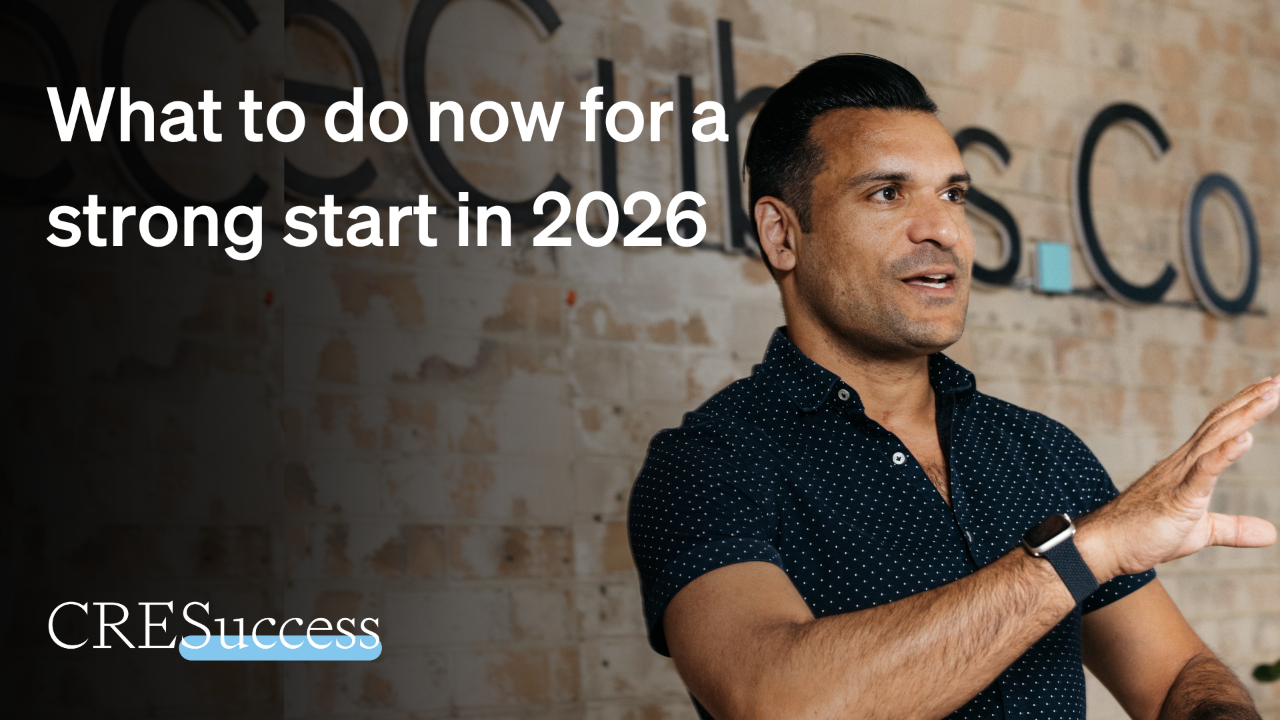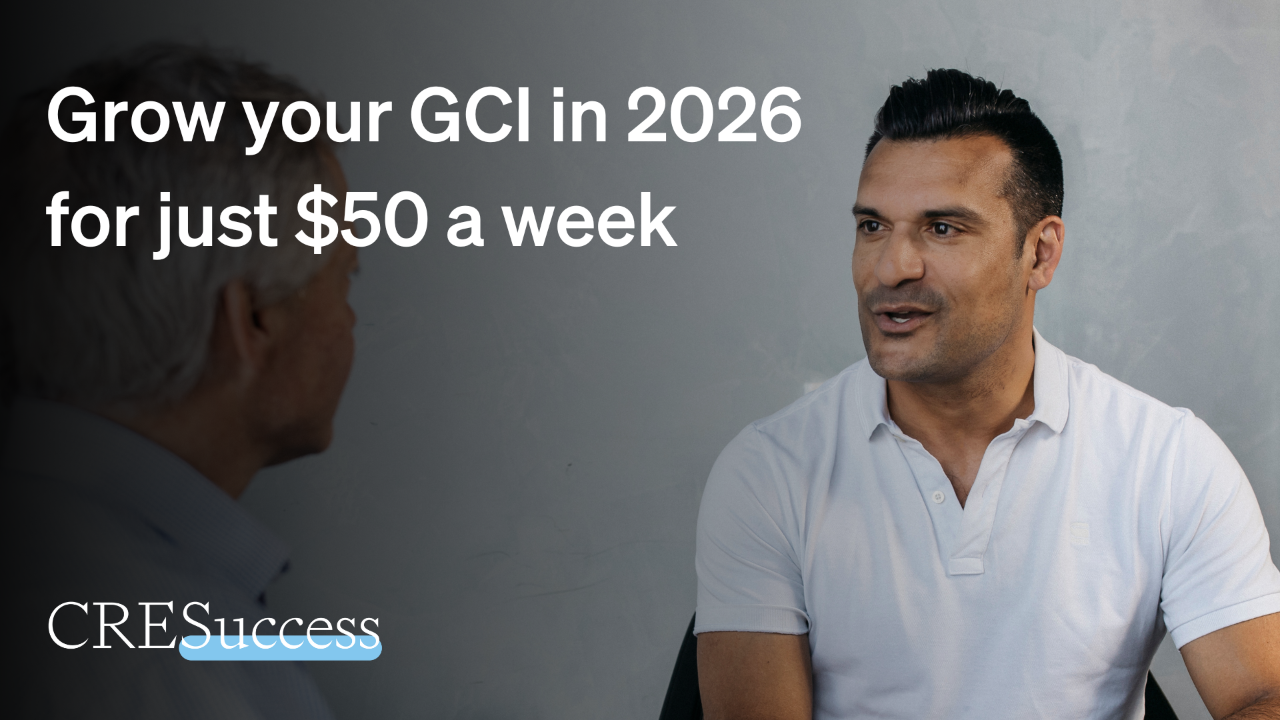Where deals are getting stuck in your pipeline.
Oct 22, 2025
CRE Success Principle: The fastest way to unlock more revenue isn’t necessarily to chase more leads. It can often be improving how effectively you move opportunities through the pipeline. Focus on where deals are getting stuck, not just on how many leads are coming in.
In commercial real estate, every transaction starts with a lead.
But a key measure of the success agents achieve is how they move leads through their pipeline.
Inside CRE Success Agent Accelerator, I recently took members through the journey that every deal travels: from lead all the way through to transaction.
Understanding each stage helps you identify where your opportunities might be getting stuck and what actions can move them forward.
The Power of Verbs
The most important actions (or verbs) that agents perform – prospecting, proposing, marketing, and negotiating – are what create motion. The results (or nouns) – like leads, meetings, listings, offers and transactions – are simply the outcomes of doing those actions consistently.
Know Your Conversion Numbers
If 100 leads turn into 25 meetings, 12 listings, and 9 deals, where could you improve? Tightening those conversion rates can unlock more revenue without needing more leads at the top.
When you focus on the quality and consistency of your actions, the results naturally follow.
If you want to understand your deal journey and build a more productive pipeline, tune in to episode 243 of Commercial Real Estate Leadership.
Episode transcript:
There is a particular journey that a commercial real estate lead goes through in order to become revenue in your business, commission for your agents, and a transaction on your books.
There are certain things that happen between a lead turning into a meeting, that is prospecting.
And then for a meeting to become a listing, we need to propose for the business.
Once we've got a listing, we then need to do some marketing in order to get some offers.
And then finally, we negotiate with buyers and tenants to turn those offers into deals, into transactions.
On our recent call inside CRE Success Agent Accelerator, I took my member through a process of understanding how they can clear the blockages in their pipeline and get more leads turning into deals, and I want to share that with you today.
This is episode 243 of Commercial Real Estate Leadership. My name's Darren Krakowiak. This is the show where we're helping you to lead better, grow faster, and stress less.
And we're doing that today by well, opening the kimono, showing you behind the curtain of one of our accountability productivity tracking sessions inside CRE Success Agent Accelerator.
I've got a clip to play from a recent call where we go through the journey that a lead takes in order to turn into transactions in your business.
And I thought I'd share this with you.
One, to give you an idea of exactly what it's like, the experience inside the program.
If maybe you're a commercial real estate agent who wants to invest in your own success or maybe you're a commercial real estate principal who'd like to put some of your agents in a program like this to provide a level of sales, leadership, Sales Management as a Service for your agents to grow revenue in your business.
And this is important, I think, because a lot of commercial real estate agents and principals think they have a leads problem, when in reality, there is often a conversion problem, and fixing that conversion problem can unlock more revenue in the business.
And I'm sharing this with you also because it's a simple framework that you might also want to share with your team.
Now, if you would like to know more about CRE Success Agent Accelerator, the best way to find out more is to get on the waitlist, and we'll be opening up some new spots soon.
To jump on the waitlist, go to cresuccess.co/waitlist
Right now, here's a look behind the scenes of a recent Accountability call with our members.
----------
I want to talk now about raising performance, and most of us are here to achieve a $100,000 increase in GCI over the next 12 months.
In fact, that's all of us have committed that as part of our PDF plan.
So, what I want to do right now is just step back and have a look at the journey of a deal, and as Christopher mentioned, you know, there's a certain deal cycle, how long does it take to turn a lead into a transaction?
And I want to go through that flow and look at where perhaps we can do some improvement in the ability of a pipeline to advance.
And I want to do that also with the context, which someone just told me the other day.
In fact, today's Wednesday, so there is now 11 weeks until Christmas.
So, what does that mean for you in terms of when is the latest that you can start a campaign in order to get a deal done by Christmas? It's probably early November, right?
If you're running 4 or 5 week campaigns, you probably want it done by the 2nd week of December.
So then, what do you need to do to line up listings to be starting by then?
Do they already need to be in your pipeline?
Is there still the opportunity to uncover some new opportunities that could be done by the end of this year?
What sort of redundancy do you have in your pipeline for any deals that fall over or any opportunities that don't convert between now and when that cutoff is?
And what I want to do with this particular exercise is just go through and talk about the different stages that we go through.
So, we start off with leads. And what do we do with leads? – Prospecting.
And then, after we've done the prospecting and qualifying, we then want to have meetings with those leads.
And at some point, we start proposing.
We're proposing that we list the property on their behalf.
If that goes well, we get the listing.
Once we've got the listing, we start marketing the property.
And then we start getting buyers or lessees.
And what do we do with them? – Negotiating.
And then finally, we have deals or transactions at the bottom.
Does everyone agree that's the basic flow?
Have I missed anything or any part of the process that you want to add.
No? Okay.
What I want you to do now is, and you can do this on the spreadsheet of your PDF plan, you can look at a new worksheet, is to literally write leads, meetings, listings, buyers, and transactions.
And then also look at the verbs that are in between those, prospecting, proposing, marketing, negotiating, and I want to do a little bit of a diagnosis on when deals are getting clogged in your pipeline.
So, the words, the nouns like leads, meetings, listing, buyers, transactions, they're the outcomes or the milestones, and everything in between are verbs, they're actions that get you from one milestone to the next.
We prospect to get the meeting, we propose to get the listing, we market to attract buyers and tenants, and we negotiate to close the deal.
So, the verbs, the doing words, the actions are what moved the pipeline and that's what turned the opportunities into outcomes.
When you've got a deal that's stuck, when you've got a lead that's not progressing, it's usually a problem with the verbs, right?
It's the action that is stalled somewhere in between those outcomes, in between the leads and the meetings or the meetings and the listings or the listings and the buyers and the buyers and the deals.
So, as you're looking at your pipeline, and looking at specific opportunities within it, I think you can just ask yourself, what's the next verb that I need to do to move this thing forward.
And that puts you, I think, in a little bit of control over how opportunities are moving through your pipeline.
Because you can't always control the result, we're not in control of when the buyer signs the contract, when the lease is finalized, but you can absolutely control the verbs and the intensity and the action that we are putting towards making things progress.
So, the amount of prospecting, the quality of the proposing, the amount of marketing that is being done, including the VPA, the vendor paid advertising that we're attracting to help us get more traction on marketing, and also the quality of the negotiating.
And I think when we stay consistent with the actions when we're doing the verbs, the nouns take care of themselves, or we've got more nouns in each next stage of the pipeline.
The listings come, the transactions flow. So, it's the doing that drives the deals.
So consistent prospecting, you know, if we got a certain number of leads and we consistent with that prospecting, we get more meetings.
We've got improved conversion mechanisms, so if we're greater progression of meetings, more proposals, more listings.
We've got more transactions, that means improved marketing and smarter negotiations with buyers and with tenants.
And also, all along the way, I think we want to be more efficient.
And, you know, Hillary talked about hiring someone to help her be more efficient.
And that's also about your productivity; it's getting better at what you do and focusing on the right things and getting more done in less time.
So, what I thought we'd do now is map out a pathway for you to get more opportunities through this pipeline.
And what I thought we would do is maybe start off with 100 leads.
So, if you put a 100 next to wherever you've put that flow, how many meetings do you get from 100 leads?
Now, I want you to have a think about, you know, if you've got 100 phone numbers, how many do you actually connect with?
It's getting hard to connect with people.
Maybe you also need to start reaching out on social media, maybe you need a better way to nurture these leads.
Maybe you need other mechanisms to get these people into conversations, to prospect them, to qualify them to have these meetings.
Maybe pop into the chat for me and we'll see if we've got a consensus so I can model up one example.
What percentage of leads convert into a meeting?
There are no right or wrong answers because it'll be, it depends on your marketplace. It depends on the amount of work that you're doing to how broad you're casting a net in terms of the leads that you're looking at.
Nathan guesses 25%.
Yeah, I was going to guess 20%.
Any other views?
Similar range, well, let's say 25% then.
So, if 25% of our leads turn into meetings, that means 100 leads gets these 25 meetings.
If we're having 25 meetings and you might not be proposing in the first meeting, but once you've got your foot in the door, it's probably easier to get the next meeting.
How many meetings turn into listings?
50%, says Jackson.
Nathan's nodding.
Alright, let's go with 50%.
So, that means we're going to get 12.5 listings from 100 leads.
Now I think the conversions start to get a little bit higher.
If we've got a listing, how likely is it that we're going to get a buyer?
80%, 90%, 100%?
70 or 80%?
So, that's about 10.
So now we've got 10 buyers from 100 leads. We're holding the listing.
Now, I know sometimes it might be exclusive or not exclusive that might impact whether you're going to have the buyer or not.
And if you're on a lot of non-exclusive listings, that's going to be a lower number for you, right? Because you're competing against other agents.
But if we've got the buyer and the lessee, then all we've got to do is negotiate terms and get the deal done.
What does that happen at?
Is that 80%, 90%.
85% to 95% exclusive, says Jackson.
80% says Luke.
90% says Nathan
I'm going to go 90%. So, then we've got 9 deals from 100 leads.
So now, we can have a look and see, first of all, we've got a little bit of consensus around the percentages at which things are flowing through this pipeline, I want you to assess, are you above or below these percentages?
Where's the opportunity for you to tighten the conversions, to create a little bit more flow through your pipeline?
If you're already performing at above the averages that we've just talked about, then maybe the mechanism for you to increase your production.
It lives up here. We just need to get more leads flowing through the top, because we're already converting at an optimal rate.
If we're not converting at an optimal rate, then probably the place to focus isn't through leads, it might be at certain stages of the pipeline to get these conversion rates at a level which means we're not burning through leaks.
Any questions or comments about this concept?
OK, what I want to do now is just to give you a couple of ideas on how you might like to do the verbs, do the actions better.
OK, so if there's a particular stage of the pipeline where you need to be focusing, just one or two tips.
There's plenty more information about all of this in your CRE Success portal.
But let me just give you a few ideas.
First of all, let's say we're prospecting and we're not prospecting, we're not getting enough meetings from the prospecting that we're doing.
One thing that we can do is be, first of all, maybe get some better-quality leads into the pipeline, but then also be better prepared for each call.
So, we might just do a little bit more research before we start dialing.
Be better prepared for each call.
Look to identify some triggers to open up the conversations which are more relevant, which is going to make those conversations flow more easily.
We might look to get people on different channels.
To ensure that we've got the opportunity to open up that conversation, not giving up too quickly following a cadence, texting them as well as calling them or emailing them or reaching out to them on social media.
There are a few ways that we can get more opportunities, more leads turning into meetings.
Proposing- if proposing is where the issue is, if not enough meetings are turning into listings. I want you to consider your position in the marketplace in the four areas that determine who wins a listing.
So how strong are your relationships?
Maybe you're asking too early.
Maybe we need to have one more meeting before we actually are proposing to build the relationship a bit more.
You're taking your shot too early.
Maybe it's about your track record. Either your track record isn't strong enough, or you're not communicating your track record in a way which demonstrates that you're a market leader or a credible alternative to the market leader.
Maybe it's about the quality of your proposal or your response.
Does it communicate your value?
Does it show you've put some time and effort into the proposal?
Does it reflect what the client is actually looking for, or is it just cookie cutter and it just looks like you haven't really put a lot of effort into it, and it doesn't speak specifically to what you've learnt about the client or the prospects requirements up to that point.
And also, there's the fee, right? So have we done a good job of 1, appraising the property, and 2, positioning our fee in a way which demonstrates value.
So, they're the 4 places I'd be looking if we're not converting opportunities from meetings into listings.
Any questions on that so far? Any comments?
Alright, let's talk about marketing then.
Alright, so let's say we've got the listing, but we're not getting 80% that are flowing through into, getting buyers and lessees to surface, right?
So, VPA is the first place I would look.
Are we selling the advertising?
Are we selling the marketing?
Do we believe in the value of marketing?
Are we putting it and presenting it in a way which communicates value?
Are we stacking, for example, some of the work that we're doing along with the total package of marketing?
So, it's not just about VPA, it's about social media.
It's about canvassing for buyers and for the lessees.
That's work that you can do as well.
So sometimes we need to do a little bit of an extra lift on top of the marketing.
How's our copywriting, how are our photos?
What's the quality of the marketing?
So that's some things on the marketing. And then with negotiating, we've got a module on negotiating.
I think it's really about communicating value clearly and managing the expectations of both parties, your client and also the buyer or the lessee.
And while you do have to represent your vendor and their best interests, sometimes you need to, you know, I'll use the word condition because that's the word that we use, but maybe we'll say educate them on what's going on in the market in order to make a deal happen.
Because if they've come this far with you, they should be committed to getting a deal done.
So, my question for you is just, we've gone through this pipeline, we've talked about where things might be getting stuck - what's the biggest needle mover potentially for you?
And if you know where that is, what can you do to move that needle?








